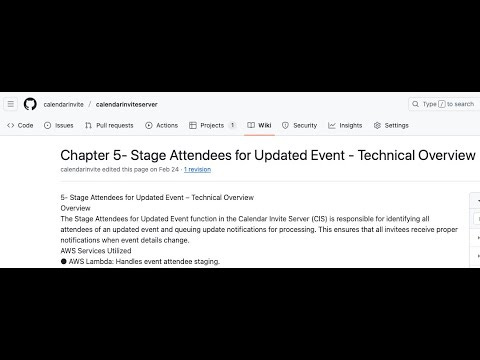What is the primary purpose of the "Stage Attendees for Updated Event" function in the Calendar Invite Server (CIS)?
The primary goal of the "Stage Attendees for Updated Event" function is to ensure that all individuals invited to an event receive timely notifications when any event details are updated. It identifies all attendees of an updated event and queues up these update notifications for processing, making the system efficient and reliable.
Which AWS services are utilized by this function, and what role does each play?
The function leverages several AWS services:
AWS Lambda: This service is responsible for executing the core logic of the function, handling the event attendee staging.
Amazon SQS (Simple Queue Service): SQS acts as a message queuing service, managing the incoming event update requests that trigger the function.
Amazon DynamoDB: This NoSQL database service is used to retrieve and store attendee records for specific events, allowing the function to identify who needs to be notified.
Amazon SNS (Simple Notification Service): SNS is used to publish update notifications to each attendee, serving as the mechanism for sending out alerts.
Can you describe the typical event processing flow for an updated event within the CIS?
The event processing flow begins with a trigger from an SQS event notification. Upon activation, the function retrieves the attendee list by querying DynamoDB for all attendees associated with the updated event. Next, it queues updates by formatting attendee details and publishing update requests to an SNS topic. Finally, the function performs cleanup by deleting the successfully processed messages from SQS to prevent them from being re-processed.
What are the key internal functions that facilitate the staging of attendees for an updated event?
The core operations are handled by several key internal functions:
lambda_handler(event, *): This is the entry point, iterating through each record received from the SQS event.
process_request_from(record): This function extracts event update details, queries DynamoDB for attendee records, queues updates for all affected attendees via SNS, and then deletes the processed SQS message.
get_attendee_list(uid): Specifically queries DynamoDB to retrieve all attendees for a given updated event.
queue_updated_event_for_processing(event, attendees): Publishes an SNS message for each attendee to notify them of the event update.
delete_successfully_processed_sqs(message): Removes messages from SQS that have been successfully processed, preventing redundant retries.
How does the system handle data, particularly attendee records, and what environmental variables are essential for its operation?
Attendee records are stored in DynamoDB with a specific structure: pk: event# and sk: attendee#. This structure helps organize attendee information and their participation status.
Essential environmental variables for the function's operation include:
REGION: Specifies the AWS region where the function executes.
DYNAMODB_TABLE: The name of the DynamoDB table where attendee data is stored.
SQS_URL: The URL of the SQS queue used for processing event updates.
EVENT_UPDATE_REQUEST: The Amazon Resource Name (ARN) of the SNS topic for publishing update notifications.
What mechanisms are in place for error handling within the "Stage Attendees for Updated Event" function?
The function incorporates several error-handling mechanisms:
Missing Attendee Records: If no attendees are found for an event, the issue is logged, and the function exits gracefully.
SNS Publishing Failures: Errors encountered during the publishing of messages to SNS are logged for troubleshooting purposes but do not halt the overall execution of the function.
Exception Logging: General errors and exceptions are logged to facilitate debugging and identify potential issues.
What is the overall benefit of automating the event update notification process using this function?
Automating the event update notification process through the "Stage Attendees for Updated Event" function significantly enhances efficiency and reliability. By leveraging AWS Lambda, SQS, DynamoDB, and SNS, it ensures that all affected attendees are promptly and consistently notified of event changes, reducing manual effort and minimizing the chances of missed communications.
Beyond event updates, what other functionalities are suggested as part of the broader Calendar Invite Server (CIS) system based on the provided source?
While the provided text focuses on staging attendees for updated events, the surrounding context and additional listed (though not fully loaded) chapters indicate a comprehensive Calendar Invite Server (CIS) system with diverse functionalities. These include:
Sending bulk event invites.
Notifying organizers of successful event creation, enrollment, or failed creation.
Managing event limits.
Getting new event requests and replies from email.
Creating new event records.
Canceling events.
Providing pre-built notification email templates.
Processing Shopify orders.
Getting various event reports (system events, organizer events, attendee reports, sanitized attendee lists).
Handling event invites from APIs.
An API overview and a dashboard for the CIS.
AI Vid












